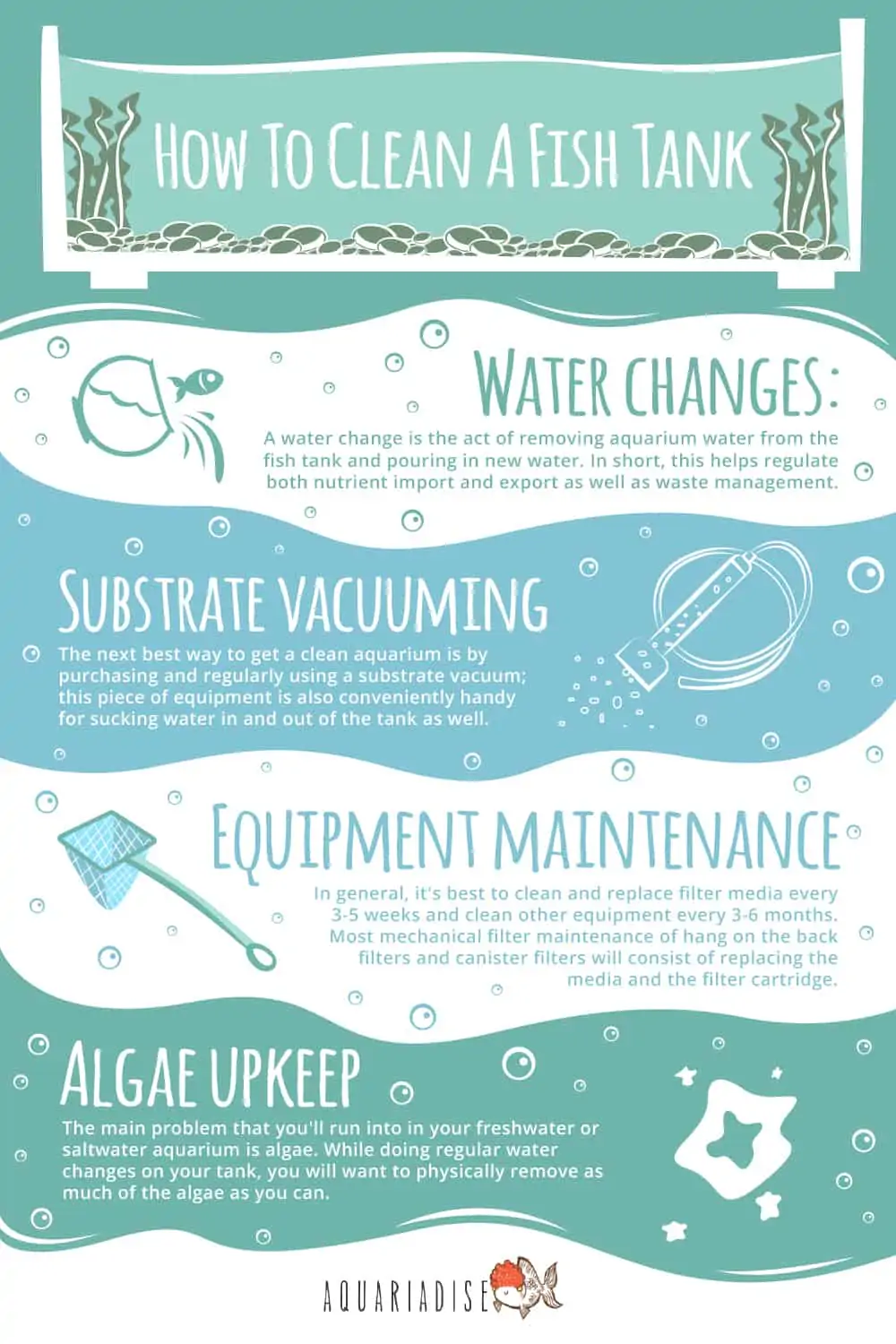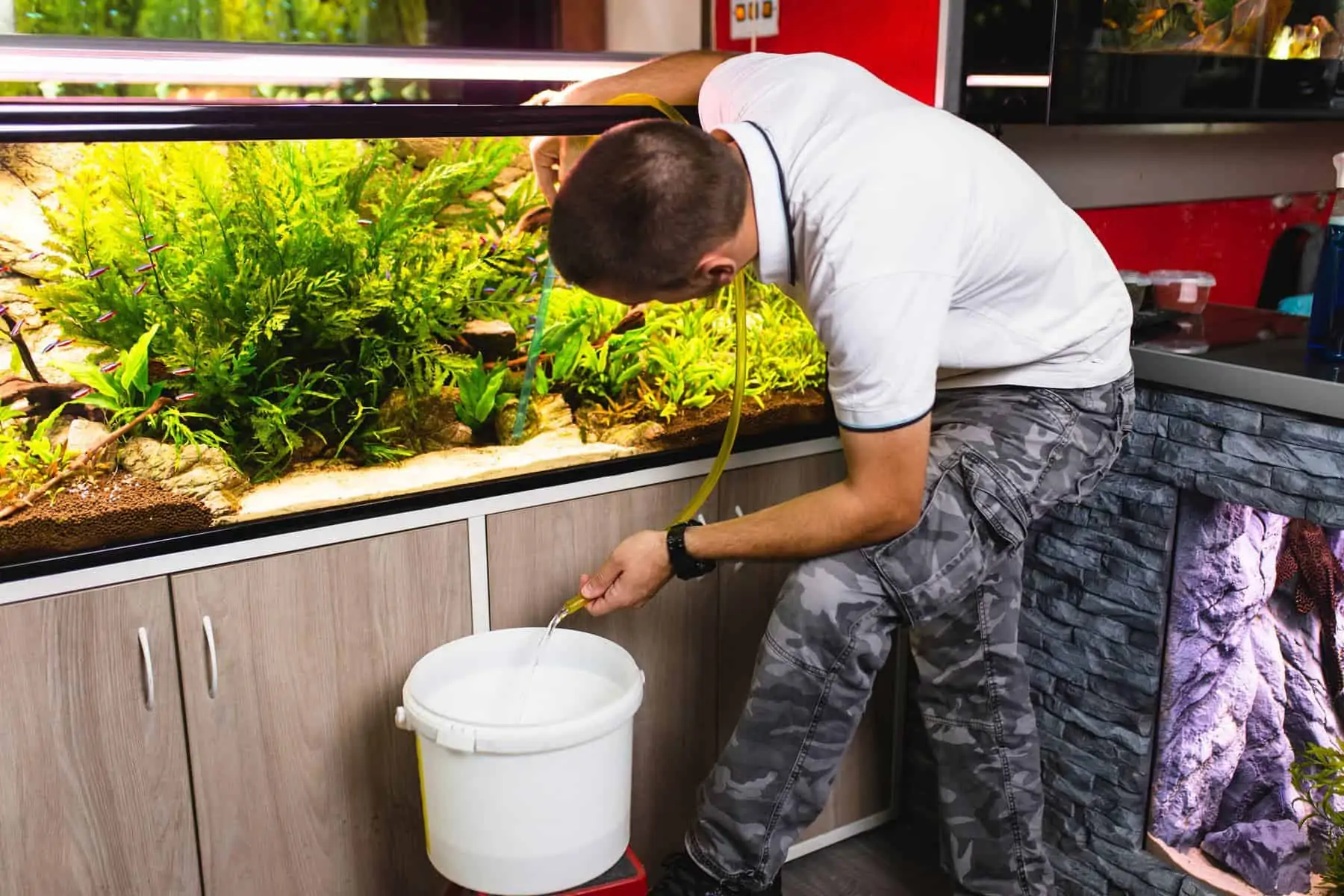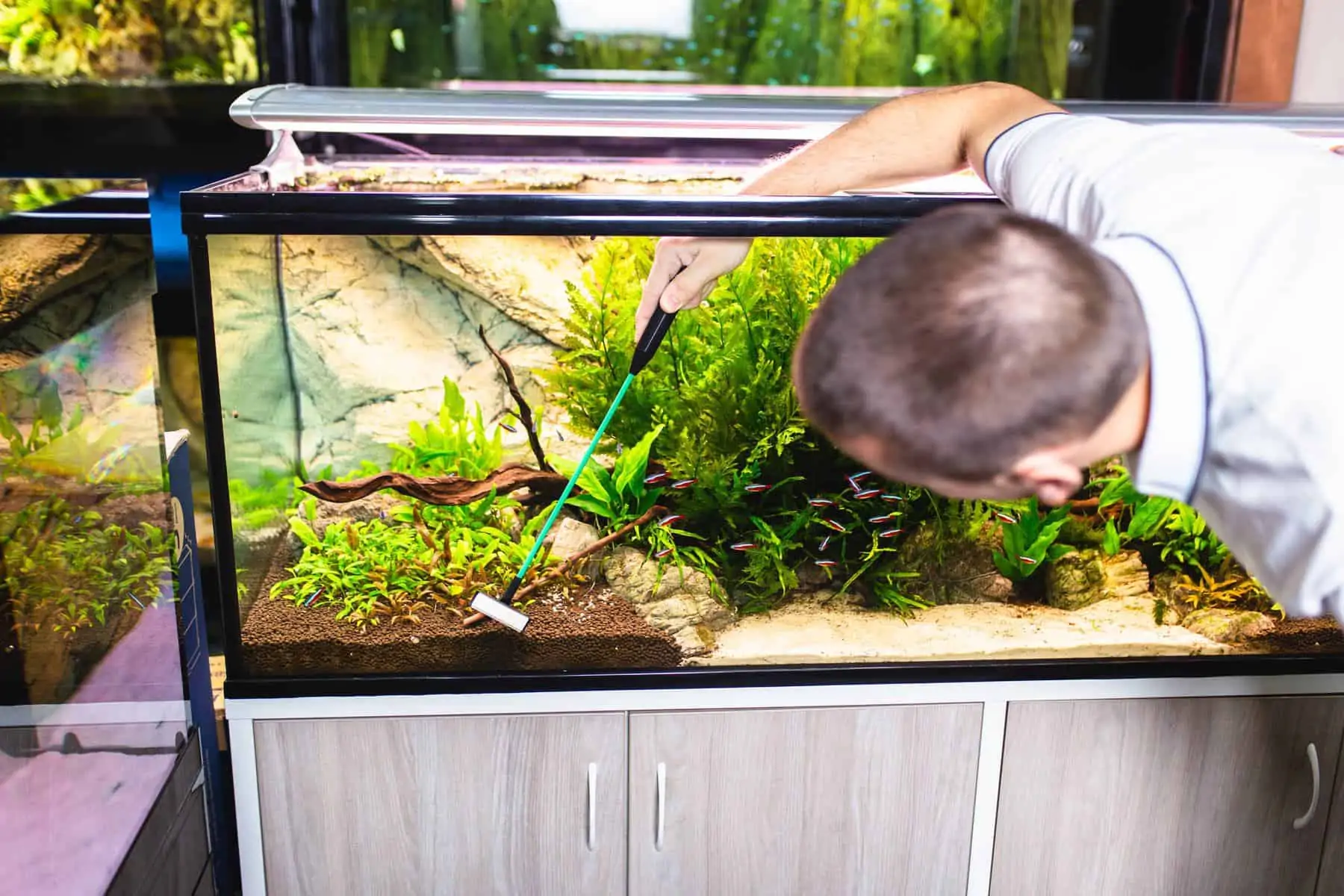Too many times, beginner hobbyists believe that fish tanks require little to no maintenance after setup. While some experienced hobbyists do run tanks that sustain themselves over years at a time, the rest of us usually need to perform some kind of maintenance at least twice a month. However, fish tank maintenance doesn’t need to be hard and the work is definitely worth the beautiful aquarium you will have in the end!
Keep reading to find out how to clean your fish tank and the easiest ways to keep your aquarium clean in the future!
Why do you need to clean your fish tank?
No matter a freshwater or saltwater tank, regular maintenance is required to have a healthy ecosystem. If you compare your enclosed aquarium to the natural habitats from which your fish and invertebrates came, you’ll notice that there are constant inputs and outputs of different species, food availability, and at a microscopic level, essential nutrients and gases. Some of these ecosystems even rely on changing seasons to operate correctly.
How can you replicate these conditions in your aquarium?
First, we need to understand what happens in your tank during maintenance. It should be noted that some hobbyists have had success performing little to no maintenance at all on their fish tanks and each system will run differently.
Regulate nutrient import and export
Probably most importantly, regular tank maintenance helps create a balance of nutrients within the system. While the nitrogen cycle–where ammonia is constantly being processed into nitrate–is always occurring in your tank, nitrate can build up and become an issue in unmaintained tanks. Regular water changes help keep these nitrates down, which can help prevent algae outbreaks.
Similarly, water changes can import and export other minerals and nutrients as well, like phosphate, calcium, and magnesium. While organisms need phosphates to perform certain physiological functions, they can also contribute to algae growth and most hobbyists need to keep a close watch on their levels. Like nitrate, excess phosphates can be regulated with water changes as long as the replacement water being used does not already have undesirable amounts.
Calcium and magnesium are two very important parameters that need to be monitored; both calcium and magnesium contribute to the general hardness of the aquarium water. Fish and invertebrates need appropriate general hardness to build bone and exoskeleton as well as to regulate metabolism and help with ion exchange. Water changes help keep calcium and magnesium levels, and the overall water hardness, in the right range for fish to grow and have a healthy lifespan.
At the same time, nutrients are being exported and imported, gases are also being exchanged. Naturally, water changes increase surface agitation which can increase the gas exchange of carbon dioxide and oxygen.
Waste management
As we’ll discuss later, vacuuming your aquarium is important for removing stuck debris, like fish waste, uneaten food, and other organic matter. If too much waste is left in the aquarium, it will begin to rot and leak ammonia into the water column. While beneficial bacteria can usually deal with smaller amounts of ammonia, if there is too much at once, it can quickly lead to deadly conditions for fish and invertebrates.
This can be especially true if you have lots of hard-to-reach places in your aquarium that trap a lot of debris. The best way to prevent ammonia spikes in your aquarium is by removing as much of this waste as possible!
How often do you need to clean your fish tank?
With that being said, how often do you need to clean your fish tank to keep it running as best that it can?
Each tank is different, but in general, most hobbyists suggest performing a 25% partial water change every two weeks with vacuuming. Smaller tanks usually need more regular maintenance as parameters can fluctuate more, and a 10% water change every week is more recommended. On the other hand, some larger tanks only need maintenance about once every month!
For most aquarium keepers, a water change and gravel vacuum every other week, filter media replacement every once a month, and equipment cleaning every 3-6 months is enough to regulate parameters.

The best way to clean your fish tank
There are many commercialized chemicals and supplements available that claim to be the best way to clean your fish tank. However, what they don’t want you to know is that most problems can be fixed with a series of water changes.
In addition to regular water changes, substrate vacuuming, equipment maintenance, and algae upkeep are truly the best ways to keep your tank clean.
Water changes

A water change is the act of removing aquarium water from the fish tank and pouring in new water. In short, this helps regulate both nutrient import and export as well as waste management. Usually, a substrate gravel vacuum, airline tubing, or a cup/bowl/bucket are used to transfer the old and new tank water; an aquarium heater may be needed to warm water before adding it.
Most hobbyists like to do a 25% partial water change every 1-2 weeks for both freshwater and saltwater aquarium setups. This is usually enough to keep nitrates and phosphates down and to keep other trace minerals and nutrients up. However, if problems are occurring in the tank, large successive >50% water changes are recommended with the idea being to gradually replace all of the water that was in the tank over a few days.
However, water changes are only as effective as the new tank water that is being introduced. If the quality of the new water is poor or drastically different from the tank, then the sudden changes can quickly stress out corals, fish, and invertebrates.
There are many different types of water available for aquariums, like tap water, distilled water, reverse osmosis water (RO water), and reverse osmosis deionized water (RO/DI). Many hobbyists have success with tap water while others have more success with purer waters; if using tap water, make sure to have a comprehensive analysis of the parameters as they can greatly differ between geographical locations.
As always, make sure to use a water conditioner to remove chlorine and heavy metals from the water! It is normal for the tank to have some cloudiness after a water change.
Substrate vacuuming
The next best way to get a clean aquarium is by purchasing and regularly using a substrate vacuum; this piece of equipment is also conveniently handy for sucking water in and out of the tank as well.
A substrate vacuum is designed to lift debris and other organic matter out of the gravel or sand of your aquarium. Many hobbyists choose to vacuum their substrate at the same time they perform a water change in order to catch any debris that gets wafted into the water column.
At the same time, a substrate vacuum can be used to reach hard to reach places behind decorations or rocks, and can even be used to suck organic matter directly off of surfaces and out of crevices.
Luckily, these vacuums are physically designed to work from gravity and suction alone and don’t require any external pumps or equipment.
Equipment maintenance
Equipment maintenance is equally as important as water changes and substrate vacuuming but doesn’t need to be done as often. In general, it’s best to clean and replace filter media every 3-5 weeks and clean other equipment every 3-6 months; protein skimmers will need to be emptied and cleaned more often.
Most mechanical filter maintenance of hang on the back filters and canister filters will consist of replacing the media and the filter cartridge. However, it’s also a good idea to completely disassemble these pieces of equipment and rinse and scrub them in a bucket of water from the aquarium every so often; never use tap water to rinse any equipment or decorations from the tank as this can kill large amounts of beneficial bacteria!
Otherwise, regularly monitor the performance of powerheads, heaters, UV sterilizers, and any other equipment. It is best to clean all aquarium equipment on a regular basis, but even more so if something seems to have decreased in performance.
Algae upkeep
The main problem that you’ll run into in your freshwater or saltwater aquarium is algae; whether your tank is a few days old or a few years old, you will deal with algae at some point or another.
The best way to treat algae is by finding the source of the problem. Usually, this is due to poor water quality, too much or too little light, inadequate water flow, overfeeding, or the tank just not being fully established yet. One of the best ways to tackle algae is by doing water changes to reach optimal water conditions that work for your setup and that work towards overall stability.
While doing regular water changes on your tank, you will want to physically remove as much of the algae as you can. This includes using an algae scrapper/magnetic scrubbers to clean the inside of the glass (make sure that you don’t have an acrylic aquarium first as this can easily scratch the glass) and vacuuming patches of algae; rocks, artificial plants, and any other aquarium decor can also be temporarily removed from the display and gently scrubbed.
There are many other methods for treating algae, including using hydrogen peroxide, aquarium light blackouts, livestock recommendations, and commercial remedies. At the end of the day, consistent water changes, the right flow, the right light, and overall stability will result in a successful aquarium.
FAQ
Here are some commonly asked questions you might have before attempting to clean your aquarium!
Do you need to take everything out of your fish tank while cleaning?
No, you do not need to take out everything from your fish tank for proper cleaning. In fact, you want to keep your hands out of the tank as much as possible and keep exposed areas to a minimum.
There is always the possibility that your hands introduce toxins into the tank and it’s recommended to use aquarium-safe gloves. Leaving aquarium decor, rocks, and equipment can also quickly cause bacteria to die off, which can cause dangerous ammonia spikes once placed back into the aquarium.
In short, you should not remove any items from the aquarium unless switching out pieces or cleaning for algae.
How do you clean a fish tank that has eggs in it?

If you happen to notice eggs on the walls of the aquarium or on other surfaces, then there isn’t too much to worry about when cleaning. In general, it’s the same process.
However, you will want to avoid creating a lot of excess flow that can dislodge the eggs. You also want to make sure that the eggs are always underwater and give a safe distance if working in that area.
Most importantly, you might want to ensure closer parameters between the tank water and the clean water when doing water changes as to not cause conditions to fluctuate too much.
Conclusion
A successful fish tank is all about how much time you’re willing to put in to make a stable ecosystem. While some hobbyists find that their tank does best on autopilot, others find that strict maintenance is the only way their aquarium survives. It is important to know where your tank is most at balance and create a schedule. Then, you can perform the needed water changes, substrate vacuumings, equipment maintenance, and algae upkeep.
If you have any questions about how to clean your fish tank, cleaning an especially dirty fish tank, or have had experience dealing with an algae outbreak, don’t hesitate to leave a comment below!


